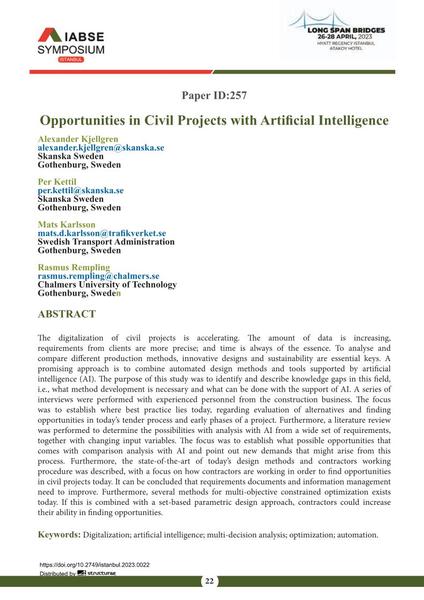Opportunities in Civil Projects with Artificial Intelligence

|
|
|||||||||||
Bibliographic Details
| Author(s): |
Alexander Kjellgren
(Skanska Sweden, Gothenburg, Sweden)
Per Kettil (Skanska Sweden, Gothenburg, Sweden) Mats Karlsson (Swedish Transport Administration Gothenburg, Sweden) Rasmus Rempling (Chalmers University of Technology Gothenburg, Sweden) |
||||
|---|---|---|---|---|---|
| Medium: | conference paper | ||||
| Language(s): | English | ||||
| Conference: | IABSE Symposium: Long Span Bridges, Istanbul, Turkey, 26-28 April 2023 | ||||
| Published in: | IABSE Symposium Istanbul 2023 | ||||
|
|||||
| Page(s): | 22-32 | ||||
| Total no. of pages: | 11 | ||||
| Year: | 2023 | ||||
| DOI: | 10.2749/istanbul.2023.0022 | ||||
| Abstract: |
The digitalization of civil projects is accelerating. The amount of data is increasing, requirements from clients are more precise; and time is always of the essence. To analyse and compare different production methods, innovative designs and sustainability are essential keys. A promising approach is to combine automated design methods and tools supported by artificial intelligence (AI). The purpose of this study was to identify and describe knowledge gaps in this field, i.e., what method development is necessary and what can be done with the support of AI. A series of interviews were performed with experienced personnel from the construction business. The focus was to establish where best practice lies today, regarding evaluation of alternatives and finding opportunities in today’s tender process and early phases of a project. Furthermore, a literature review was performed to determine the possibilities with analysis with AI from a wide set of requirements, together with changing input variables. The focus was to establish what possible opportunities that comes with comparison analysis with AI and point out new demands that might arise from this process. Furthermore, the state-of-the-art of today’s design methods and contractors working procedure was described, with a focus on how contractors are working in order to find opportunities in civil projects today. It can be concluded that requirements documents and information management need to improve. Furthermore, several methods for multi-objective constrained optimization exists today. If this is combined with a set-based parametric design approach, contractors could increase their ability in finding opportunities. |
||||
| Keywords: |
optimization automation digitalization artificial intelligence multi-decision analysis
|
||||
